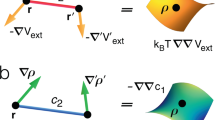Summary
Closed formulas for small fluctuations are obtained for the case of macroscopic quantities which can be written as an integral inμ-space (one-particle phase-space) of the form ∫ϰ(x, p, ϱ(x, p))dxdp, whereχ is an arbitrary function of co-ordinates, momentum, and of particle density ϱ(x, p). The second-order approximation of Einstein’s expression is employed. Comparison is made with the fluctuations in energ and occupation numbers derived from Darwin-Fowler technique and from the Canonical and Grand Canonical ensembles. The physical meaning of the results obtained is discussed.
Riassunto
Si ottengono formule chiuse per le piccole fluttuazioni nel caso di quantità macroscopiche che possono essere scritte sotto forma di un integrale nello spazioμ (spazio delle fasi di una particella) della forma εχ(x, p, ϱ(x, p) dxdp, in cuiχ è una funzione arbitraria delle coordinate, dell’impulso e della densità delle particelle ϱ(x, p). Si usa l’approssimazione di secondo ordine dell’espressione di Einstein. Si fa il confronto con le fluttuazioni in energia e numero d’occupazione dedotte con la tecnica di Darwin-Fowler e dagli insiemi canonico e gran canonico. Si discute il significato fisico dei risultati ottenuti.
Similar content being viewed by others
Literatur
A. Einstein:Ann. d. Phys.,33, 1275 (1910).
R. F. Greene andH. B. Callen:Phys. Rev.,83, 1231 (1951).
Although expressions (4) and (5) can also be derived without the help of approximation (2) (see ref. (2)) we will limit ourselves to this simpler case, since a similar approximation will be employed in the explicit calculations of the next Section.
L. Onsager:Phys. Rev.,38, 2265 (1931).
D. Ter Haar:Elements of Statistical Mechanics (New York, 1960), p. 75.
P. A. M. Dirac:The Principles of Quantum Mechanics, 4th Ed. (Oxford, 1958), p. 238.
O. Bolza:Lectures on the Calculus of Variations (New York, 1946), p. 208.
C. G. Darwin andR. H. Fowler:Phil. Mag.,44, 450 (1922).
C. G. Darwin andR. H. Fowler:Proc. Camb. Phil. Soc.,21, 391 (1922).
R. H. Fowler:Statistical Mechanics (Cambridge, 1955), p. 748, 753, 755.
R. C. Tolman:The Principle of Statistical Mechanics (Oxford, 1938), Section141.
R. Courant andD. Hilbert:Methods of Mathematical Physics, vol.1 (New York, 1953), p. 61.
Author information
Authors and Affiliations
Additional information
Most of this work was done during the author’s stay at Centro Brasileiro de Pesquisas Físicas, Rio de Janeiro.
Rights and permissions
About this article
Cite this article
da Costa, R.C.T. On fluctuations in statistical mechanics. Nuovo Cim 32, 654–678 (1964). https://doi.org/10.1007/BF02735889
Received:
Published:
Issue Date:
DOI: https://doi.org/10.1007/BF02735889




